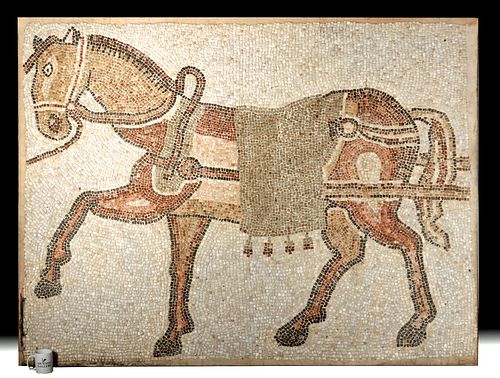Enormous Roman Mosaic of a Striding Horse
Lot 59a
About Seller
Artemis Fine Arts
686 S Taylor Ave, Ste 106
Louisville, CO 80027
United States
Selling antiquities, ancient and ethnographic art online since 1993, Artemis Gallery specializes in Classical Antiquities (Egyptian, Greek, Roman, Near Eastern), Asian, Pre-Columbian, African / Tribal / Oceanographic art. Our extensive inventory includes pottery, stone, metal, wood, glass and textil...Read more
Categories
Estimate:
$25,000 - $35,000
Absentee vs Live bid
Two ways to bid:
- Leave a max absentee bid and the platform will bid on your behalf up to your maximum bid during the live auction.
- Bid live during the auction and your bids will be submitted real-time to the auctioneer.
Bid Increments
| Price | Bid Increment |
|---|---|
| $0 | $25 |
| $300 | $50 |
| $1,000 | $100 |
| $2,000 | $250 |
| $5,000 | $500 |
| $10,000 | $1,000 |
| $20,000 | $2,500 |
| $50,000 | $5,000 |
| $100,000 | $10,000 |
| $200,000 | $20,000 |
About Auction
By Artemis Fine Arts
Feb 13, 2020
Set Reminder
2020-02-13 10:00:00
2020-02-13 10:00:00
America/New_York
Bidsquare
Bidsquare : Exceptional Antiquities, Asian, Ethnographic
https://www.bidsquare.com/auctions/artemis-gallery/exceptional-antiquities-asian-ethnographic-4848
An important one-day auction featuring museum-worthy examples of Egyptian, Greek, Roman, Etruscan, Near Eastern, Far East / Asian, Pre-Columbian, African / Tribal, Oceanic, Native American, Spanish Colonial, Russian, Fossils, Ancient Jewelry, Fine Art, so much more! Artemis Fine Arts info@artemisgallery.com
An important one-day auction featuring museum-worthy examples of Egyptian, Greek, Roman, Etruscan, Near Eastern, Far East / Asian, Pre-Columbian, African / Tribal, Oceanic, Native American, Spanish Colonial, Russian, Fossils, Ancient Jewelry, Fine Art, so much more! Artemis Fine Arts info@artemisgallery.com
- Lot Description
Late Roman, Imperial Period, ca. 4th to 6th century CE. A spectacular mosaic on a grand scale depicting a horse striding left who is fitted to pull a hunting cart or chariot. Painstakingly created from thousands of stone tesserae, the equine is delineated with a lively sense of motion, lifting his front left leg, weight shifted to his front right leg, the rear legs following in a gallop. The volumes of the horse's body are rendered with tesserae of many shades - sienna, russet, creamy white, tawny beige, yellow ochre, and black - resulting in naturalistic features so as to provide a sense of three dimensionality and life! The saddle comprised of taupe, olive, and sage tesserae with russet and sage tassels as well as the bridle, reigns and other fittings suggest that this horse is pulling an elite individual or cargo of importance. Size: 83.5" W x 65.75" H (212.1 cm x 167 cm)
Mosaics (opus tesellatum) are some of our most enduring images from the Roman world, exciting not only for their aesthetic beauty, but also because they reveal what Romans chose to depict and see every day decorating their private and public spaces. Horses were a popular subject of mosaics, especially mosaics from Roman North Africa, where the horses of Algeria (known as Numidia) were renowned, and citizens were passionate about chariot races and hunting. One mosaic found there, for example, portrays a race horse with the words, "Win or lose, we love you, Polidoxus." This horse mosaic likely portrays a hunting scene, as we would expect to see a chariot horse alongside others as in the recently discovered mosaic found at Akaki, Cyprus. Rather, this horse is likely from a scene similar to the one in the Bardo Museum, Tunisia, that depicts a hunting party where the horse Leonidas is pulling his rider alongside several other horses and riders wearing bridles and reins. It was made by a master artisan, probably to grace an elite family's villa.
Accompanied by a descriptive letter written by Dr. Karl Kilinski II, Classical Archaeologist & Art Historian at Southern Methodist University to Civilization Gallery, Dallas, Texas and dated February 18, 1993.
Provenance:private Dallas, Texas, USA collection, acquired before 1994; Accompanied by a descriptive letter written by Dr. Karl Kilinski II, Classical Archaeologist & Art Historian at Southern Methodist University to Civilization Gallery, Dallas, Texas and dated February 18, 1993.
All items legal to buy/sell under U.S. Statute covering cultural patrimony Code 2600, CHAPTER 14, and are guaranteed to be as described or your money back.
A Certificate of Authenticity will accompany all winning bids.
We ship worldwide and handle all shipping in-house for your convenience.
#146677Set in modern matrix with metal framing. Expected chips to tesserae with areas of loss as shown. Nice scattered mineral deposits on tesserae. Fissures to the plaster matrix with areas of loss to the matrix bordering the lower left corner.Condition
- Shipping Info
-
All shipping is handled in-house for your convenience. Your invoice from Artemis Gallery will include shipping calculation instructions. If in doubt, please inquire BEFORE bidding for estimated shipping costs for individual items.
-
- Buyer's Premium



 EUR
EUR CAD
CAD AUD
AUD GBP
GBP MXN
MXN HKD
HKD CNY
CNY MYR
MYR SEK
SEK SGD
SGD CHF
CHF THB
THB














